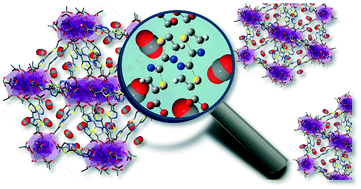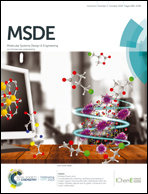Computational screening, synthesis and testing of metal–organic frameworks with a bithiazole linker for carbon dioxide capture and its green conversion into cyclic carbonates†
Abstract
Computational crystal construction algorithms were used to create twelve metal–organic frameworks containing a newly synthesized [2,2′-bithiazole]-5,5′-dicarboxylic acid (H2TzTz) spacer and assorted transition metal nodes. Among the twelve structures, the zirconium-based MOF of general formula [Zr6O4(OH)4(TzTz)6] (1) was found to be the best candidate for carbon dioxide uptake, as judged from the results of the grand canonical Monte Carlo (GCMC) simulations of CO2 adsorption isotherms. Guided by the simulation results, 1 was synthesized in the laboratory and thoroughly characterized. 1 is isoreticular to its bithiophene and bis(benzene) (UiO-67) analogues; it crystallizes in the cubic Pn![[3 with combining macron]](https://www.rsc.org/images/entities/char_0033_0304.gif) space group with fcu topology, and it features octahedral [Zr6] nodes connected by twelve carboxylate groups from six bridging TzTz2− spacers. It is a predominantly microporous material (micropore volume = 84% of the total pore volume), with a BET area of 840 m2 g−1 and a maximum CO2 uptake at ambient pressure of 2.3 mmol g−1 (10.0 wt%) or 1.7 mmol g−1 (7.5 wt%) at 273 or 298 K, respectively. The CO2 affinity (isosteric heat of adsorption Qst = 18.7 kJ mol−1; CO2/N2 Henry selectivity = 10; CO2/N2 IAST selectivity = 8.4) is similar to that of its bithiophene analogue. After partial removal of solvent (activation), 1 was tested as a heterogeneous catalyst in the reaction of CO2 with epoxides bearing a –CH2X pendant arm (X = Cl: epichlorohydrin; X = Br: epibromohydrin) to give the corresponding cyclic carbonates at T = 393 K and pCO2 = 1 bar under green (solvent- and co-catalyst-free) conditions. A good conversion of 74% and a turnover frequency of 12.3 mmol (cyclic carbonate) per mmolZr per h have been recorded with epibromohydrin as a substrate.
space group with fcu topology, and it features octahedral [Zr6] nodes connected by twelve carboxylate groups from six bridging TzTz2− spacers. It is a predominantly microporous material (micropore volume = 84% of the total pore volume), with a BET area of 840 m2 g−1 and a maximum CO2 uptake at ambient pressure of 2.3 mmol g−1 (10.0 wt%) or 1.7 mmol g−1 (7.5 wt%) at 273 or 298 K, respectively. The CO2 affinity (isosteric heat of adsorption Qst = 18.7 kJ mol−1; CO2/N2 Henry selectivity = 10; CO2/N2 IAST selectivity = 8.4) is similar to that of its bithiophene analogue. After partial removal of solvent (activation), 1 was tested as a heterogeneous catalyst in the reaction of CO2 with epoxides bearing a –CH2X pendant arm (X = Cl: epichlorohydrin; X = Br: epibromohydrin) to give the corresponding cyclic carbonates at T = 393 K and pCO2 = 1 bar under green (solvent- and co-catalyst-free) conditions. A good conversion of 74% and a turnover frequency of 12.3 mmol (cyclic carbonate) per mmolZr per h have been recorded with epibromohydrin as a substrate.



 Please wait while we load your content...
Please wait while we load your content...
